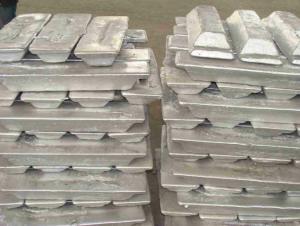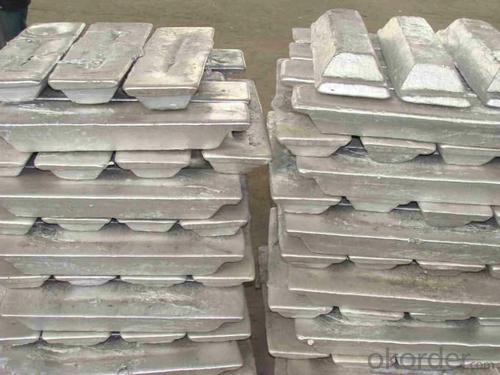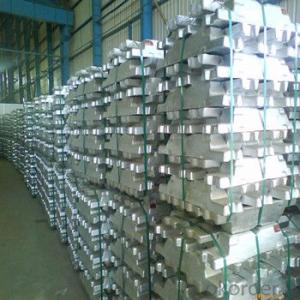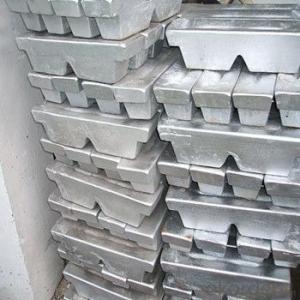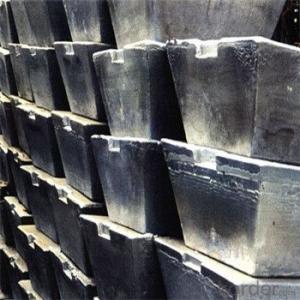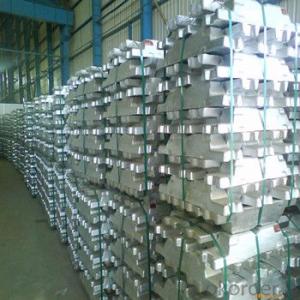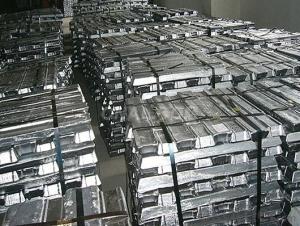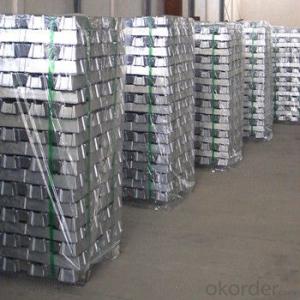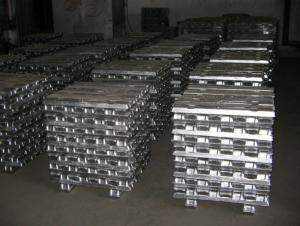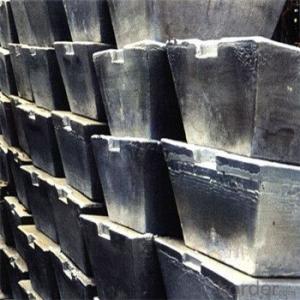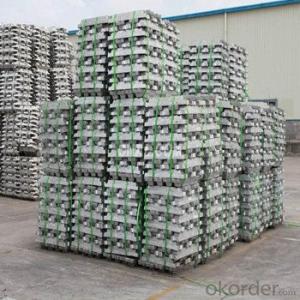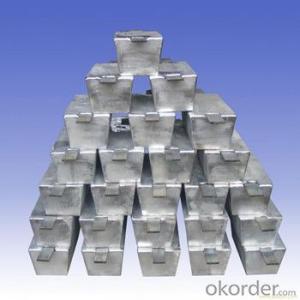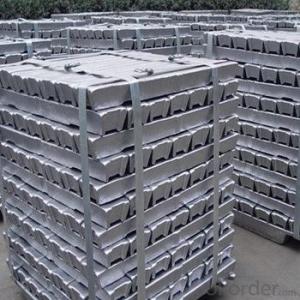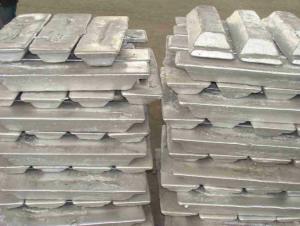Aluminum Ingots AA5052
- Loading Port:
- Shanghai
- Payment Terms:
- TT or LC
- Min Order Qty:
- 20 Tons m.t.
- Supply Capability:
- 1000 Sets Per Month m.t./month
OKorder Service Pledge
Quality Product, Order Online Tracking, Timely Delivery
OKorder Financial Service
Credit Rating, Credit Services, Credit Purchasing
You Might Also Like
1. Specifications of Aluminum Ingots AA5052
| Product Name | Aluminum Ingot |
| Chemical Composition | Al |
| Weight | 20/25kg |
| Al (Min) | 99%-99.9% |
| Appearance | silvery white |
| Advantages | easy control and operation, fast melting |
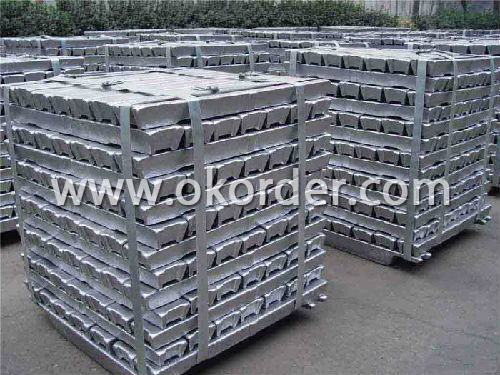
2. Usage/Application of Aluminum Ingots AA5052
A. mainly used for melting ingot
B. discontinuous melting with scrap
3.Packaging & Delivery of Aluminum Ingots AA5052
About 25Kg /Ingot, Packed in wooden case, Net weight 1000Kg/ Case, or as customer's requirements.
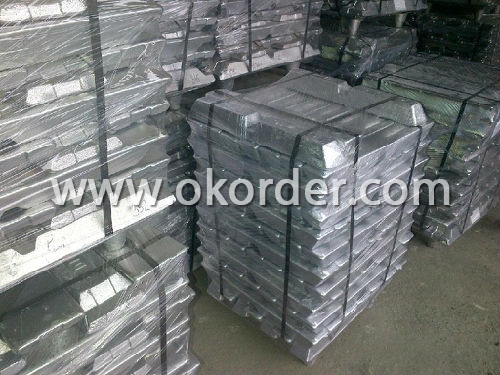
- Q: What are the main components of aluminum ingots?
- Aluminum ingots primarily consist of aluminum metal, containing small amounts of impurities. They are produced through the smelting of aluminum ore, typically bauxite, which contains aluminum oxide. The ore undergoes processing to extract the aluminum oxide, which is then refined and melted to create the ingots. These ingots generally contain 99% or more pure aluminum, with the remaining percentage comprising impurities like silicon, iron, copper, magnesium, and other elements. The specific production process and quality of raw materials used may cause variations in the impurity composition. Nonetheless, the high purity of aluminum ingots ensures their suitability for diverse industrial applications, including the manufacturing of various aluminum products.
- Q: How much is the price of the common aluminum sheet on the basis of the aluminum ingot? How much is the price of the broken aluminum alloy profile on the basis of the aluminum ingot?
- According to different manufacturers and brands, processing costs are slightly different, the general profiles of the higher processing costs, quality and material aspects can be guaranteed, small factories processing fees lower.
- Q: How are aluminum ingots tested for quality?
- To ensure compliance with required standards, aluminum ingots undergo a rigorous series of quality tests. These tests encompass multiple procedures, including visual examination, mechanical analysis, chemical assessment, density and hardness measurements, and non-destructive testing. The visual inspection is a fundamental examination of the ingots' external appearance. Inspectors meticulously scrutinize the surface for any signs of defects, such as cracks, dents, or irregularities. This evaluation serves as an indicator of the ingots' overall quality and integrity. Mechanical tests are then conducted to gauge the strength and durability of the aluminum ingots. Among these tests, tensile strength assessments are performed to determine the maximum stress the ingots can endure before fracturing. These evaluations provide crucial insights into the ingots' structural soundness and resistance to external forces. Chemical analysis constitutes another pivotal aspect of the quality testing process for aluminum ingots. It involves identifying the metal's chemical composition and purity. To accomplish this, samples are extracted from the ingots and subjected to techniques such as spectroscopy or mass spectrometry. These methods aid in uncovering the presence of any impurities or elements that might impact the aluminum's quality. The density and hardness of the ingots are also measured to ensure compliance with specified criteria. Density assessments aid in determining the consistency of the molten metal during the casting process. Hardness tests, on the other hand, shed light on the ingots' strength and resistance. Furthermore, non-destructive testing methods, such as ultrasonic testing or X-ray inspection, are employed to detect any concealed flaws or inconsistencies within the ingots. These techniques are invaluable in identifying internal defects that could compromise the quality of the aluminum. In conclusion, aluminum ingots undergo a comprehensive testing process encompassing visual inspection, mechanical analysis, chemical assessment, density and hardness measurements, and non-destructive testing. These meticulous tests guarantee that the ingots satisfy the necessary quality standards, rendering them suitable for further utilization across diverse industries.
- Q: How is aluminium ingot made?
- Aluminium is a silvery white metal, second only to oxygen and silicon in the earth's crust, and ranks third. The density of aluminum is small, only 34.61% of iron and 30.33% of copper, so it is also called light metal. Aluminum is the world's output and consumption of ferrous metals only next to steel. The density of aluminum is only about 2.7103g/cm3, about 1/3 of the density of steel, copper or brass.
- Q: How are aluminum ingots used in the production of electrical connectors?
- Aluminum ingots are used in the production of electrical connectors as they provide a lightweight and durable material that is essential for efficient and reliable electrical connections. The ingots are melted down and cast into different connector shapes, ensuring the desired conductivity and strength. Aluminum's high electrical conductivity allows for efficient transmission of electricity, while its corrosion resistance ensures longevity of the connectors. These ingots are also easily malleable, allowing for precise shaping and customization of connectors to meet various electrical requirements.
- Q: What are the main factors influencing the choice between aluminum ingots and aluminum wires?
- The main factors influencing the choice between aluminum ingots and aluminum wires are the intended use, cost, and convenience. Firstly, the intended use plays a significant role in determining whether aluminum ingots or aluminum wires are more suitable. Aluminum ingots are raw materials typically used in manufacturing processes, where they can be melted and cast into various shapes, such as sheets, bars, or profiles. They are commonly used in industries like construction, automotive, and aerospace. On the other hand, aluminum wires are primarily used for electrical applications, such as wiring systems, power transmission, and electrical components. Therefore, the specific purpose of the aluminum product needed will greatly influence the choice between ingots and wires. Secondly, cost is an important factor in decision-making. Aluminum ingots usually have a lower cost compared to aluminum wires. This is because ingots are the basic form of aluminum and require further processing to become wires, which involves additional manufacturing steps and costs. However, it is important to consider the overall project requirements, as using aluminum wires directly can save costs associated with additional processing and labor. Lastly, convenience also plays a role in the choice between aluminum ingots and aluminum wires. Aluminum wires are readily available in the market and can be easily purchased in various sizes and specifications. They are already in a usable form and can be directly installed or integrated into electrical systems. On the other hand, aluminum ingots may require additional processing, such as melting, casting, and shaping, before they can be used in a specific application. Therefore, if time and resources are limited, aluminum wires may be a more convenient choice. In conclusion, the main factors influencing the choice between aluminum ingots and aluminum wires are the intended use, cost, and convenience. Understanding the specific requirements of the project, considering the associated costs, and evaluating the convenience of each option will help in making an informed decision.
- Q: Sincerely ask predecessors to tell me about the processing of aluminum ingots to doors and windows, curtain walls, aluminum profiles, the general process and about the process!
- The first cast aluminum rod, generally with the same level hot top casting equipment, casting equipment Woge Gustave America more now.
- Q: Does aluminum ingots produced without aluminum ore belong to metal smelting?
- Smelting principle1. reduction method: metal oxides (together with reducing agents) - free metals2., replacement method: metal salt solution (add active metal) - free metal3. electrolysis: molten metal salts (electrolysis) - - free metals (metal elements)
- Q: What are the different methods for machining aluminum ingots?
- There are several different methods for machining aluminum ingots, including CNC milling, turning, drilling, grinding, and sawing. These methods allow for the precise shaping, cutting, and finishing of aluminum ingots to create various components and products.
- Q: How are aluminum ingots used in the production of aerospace components?
- The unique properties and characteristics of aluminum ingots make them crucial for aerospace component production. Melting and refining these ingots creates high-quality aluminum alloys designed specifically for the demanding requirements of the aerospace industry. Aluminum is widely used in aerospace manufacturing for several reasons. Its low density reduces the overall weight of aircraft, resulting in improved fuel efficiency and increased payload capacity. This is especially important in aerospace, where saving even a kilogram leads to significant cost savings and operational advantages. Another advantage of aluminum ingots is their excellent strength-to-weight ratio. By combining aluminum with elements like copper, magnesium, or zinc, aerospace engineers can create strong alloys while maintaining a low weight. These alloys are used to manufacture components like airframes, wings, fuselage sections, and structural supports that need to withstand extreme conditions and stresses during flight. Furthermore, aluminum ingots offer exceptional corrosion resistance, making them ideal for aerospace applications. Aircraft endure harsh environments with moisture, saltwater, and temperature fluctuations. The natural oxide layer on aluminum alloys derived from these ingots provides a protective barrier against corrosion, ensuring the longevity and durability of aerospace components. Additionally, aluminum ingots can be easily cast, machined, and formed into intricate shapes and designs, allowing for the production of complex aerospace components with high precision. This versatility is crucial in the aerospace industry, where specific needs and requirements of different aircraft models must be met. In conclusion, aluminum ingots are essential for aerospace component production due to their lightweight nature, excellent strength-to-weight ratio, corrosion resistance, and versatility in manufacturing processes. By utilizing these ingots and their derived alloys, aerospace manufacturers can achieve a perfect balance between performance, durability, and efficiency in their aircraft, contributing to the advancement and safety of the aerospace industry.
We are a well-known enterprise specializing in the production and sales of aluminum sheets and coils.
Since the establishment of us, we have been devoted to setting up a good CIS and completely implementing ISO9001 quality management system.
1. Manufacturer Overview
| Location | Henan,China |
| Year Established | 1993 |
| Annual Output Value | Above US$200 Million |
| Main Markets | Mid East;Eastern Europe;North America |
| Company Certifications | ISO 9001:2000;ISO 14001:2004;OHSAS 18001 |
2. Manufacturer Certificates
| a) Certification Name | |
| Range | |
| Reference | |
| Validity Period |
3. Manufacturer Capability
| a) Trade Capacity | |
| Nearest Port | Shanghai |
| Export Percentage | 30%-50% |
| No.of Employees in Trade Department | 21-50 People |
| Language Spoken: | English;Chinese |
| b) Factory Information | |
| Factory Size: | Above 100,000 square meters |
| No. of Production Lines | Above 10 |
| Contract Manufacturing | OEM Service Offered;Design Service Offered |
| Product Price Range | Average |
Send your message to us
Aluminum Ingots AA5052
- Loading Port:
- Shanghai
- Payment Terms:
- TT or LC
- Min Order Qty:
- 20 Tons m.t.
- Supply Capability:
- 1000 Sets Per Month m.t./month
OKorder Service Pledge
Quality Product, Order Online Tracking, Timely Delivery
OKorder Financial Service
Credit Rating, Credit Services, Credit Purchasing
Similar products
Hot products
Hot Searches
Related keywords
